
Podcast: Play in new window | Download (Duration: 46:07 — 37.0MB) | Embed
Subscribe: Apple Podcasts | Spotify | Email | RSS | More
Exploring Youth Clubhouses, drop-in centers for youth in recovery from/at risk for substance use disorders, focusing on access, partnerships, & peer support.
About the Show
Welcome to Health Hats, learning on the journey toward best health. I am Danny van Leeuwen, a two-legged, old, cisgender, white man with privilege, living in a food oasis, who can afford many hats and knows a little about a lot of healthcare and a lot about very little. Most people wear hats one at a time, but I wear them all at once. I’m the Rosetta Stone of Healthcare. We will listen and learn about what it takes to adjust to life’s realities in the awesome circus of healthcare. Let’s make some sense of all this.
We respect Listeners, Watchers, and Readers. Show Notes at the end.
Watch on YouTube
Read
The same content as the podcast, but not a verbatim transcript. A newsletter-like version with images. Could be a book chapter. download the printable transcript here
Contents
Youth Clubhouses, safe places 07:27. 3
Access to the Clubhouse 10:23. 4
Community partnership and collaboration 13:22. 4
Youth program engagement and leadership 17:03. 5
A word from our sponsor, Abridge 19:03. 6
Coping tools in your toolbox 19:48. 6
Policy change, harm reduction 28:23. 7
OASAS: Office of Addiction Supports and Services 31:01. 8
Narcan and Harm reduction 34:36. 9
Tribute to Casey Quinlan 39:53. 10
Tribute to Michael Funk 43:46. 11
Episode
Proem
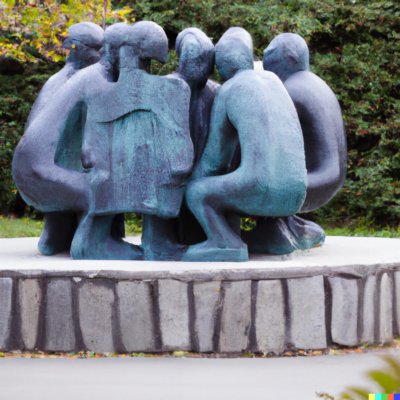
| Figure 1: DALL.E image of Sculpture of community-based research in style of Yoshitoshi Kanemaki |
I gravitate toward, am attracted to, community-based programs that build partnerships with their participants. The programs serve well, plant seeds, build capacity, and inspire copying. Medical, professional, or larger companies have a more challenging time serving, planting, building, and inspiring. Perhaps it’s a function of community-based and partnerships with lived-experience experts. I thank Dorothy Cucinelli, last episode’s guest, for introducing Paul Taylor and the Youth Clubhouses at the Mental Health Association of Columbia Greene Counties.
Youth Clubhouses are drop-in centers for youth and young adults in recovery from or at risk of developing a substance use disorder. These programs provide recovery supports – including peer support – as well as skill-building and community engagement opportunities, educational and vocational support, recreational and prosocial activities, family engagement activities, and sessions on health and wellness. Youth and Young Adults | Office of Addiction Services and Supports (ny.gov)
Youth Clubhouses are programs of NY State OASAS.
The New York State Office of Addiction Services and Supports (OASAS) oversees one of the nation’s largest Substance Use Disorder systems of care. Approximately 1,700 prevention, treatment, and recovery programs serve over 680,000 individuals per year. About Us | Office of Addiction Services and Supports (ny.gov)
Kai Hellman invited Paul Taylor and Phoebs Potter to join us. We spoke about youth access to the Clubhouse, Clubhouse partnerships in their communities, youth engagement and leadership, peer support, and harm reduction.
We will end the episode with two tributes, one of Mighty Casey Quinlan who died a couple of weeks ago and to my son, Mike Funk who would have been 47 on May 17th.
Podcast intro 02:45
Welcome to Health Hats, the Podcast. I’m Danny van Leeuwen, a two-legged cisgender old white man of privilege who knows a little bit about a lot of healthcare and a lot about very little. We will listen and learn about what it takes to adjust to life’s realities in the awesome circus of healthcare. Let’s make some sense of all of this. Like what you’re reading, hearing, or watching? Please support us on Patreon. Link in the show notes. https://patreon.com/healthhats. Membership benefits will include subscriber-only on-mic episodes sharing behind the scenes of podcasting, advocating, musicianship, and life, your name on the producer wall on my website and show notes, mp3s of me playing the sax, invitations to live Zoom chats with fellow subscribers, personal calls and coaching and mentoring with me. Thank you.
Health is fragile 04:08
Health Hats: Greetings. Thank you very much for joining us today. I have three guests with me, and I will let you introduce yourselves and briefly tell us about when you first realized health was fragile. Paul, do you want to start?
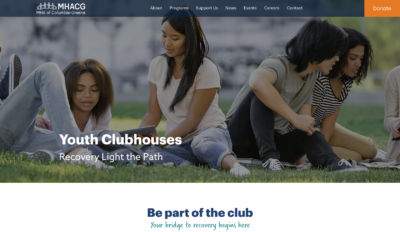
https://www.mhacg.org/clubhouses
Paul Taylor: Sure, my name’s Paul Taylor, the Director of Communications and Development for the Mental Health Association. I started in the spring with the agency, trying to put a good spotlight on mental health for the community, build up some of our agency resources, and how we interact with the community. Healthcare is definitely fragile for everyone, especially with the pandemic taking a toll on everyone for their health and well-being. How we approach our livelihood has become very important to overcome for the communities.
Health Hats: Thank you. That’s the Mental Health Association of Columbia Greene Counties in upstate New York. Okay. Phoebs, do you want to go next?
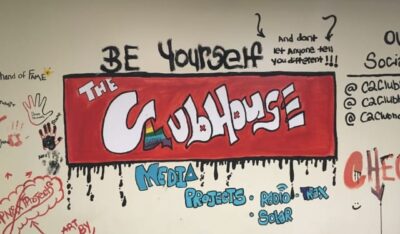
https://facebook.com/c2clubhouse
Phoebs Potter: I’m Phoebs Potter. I work with the Youth Clubhouses at the Mental Health Association of Columbia Greene. We work with young adults and 12 to 18-year-olds on prevention and recovery support. Recognizing health is fragile is the reason we exist. The significant part of the fragility we don’t always think about enough, is the interconnectedness of all aspects of health. From social health to spiritual health, to physical health, to mental health, they’re not so separate. They affect one another. So, if one part of your life is going hard, it can hit all the others. We try to think about our approach holistically in that regard.
Health Hats: Thank you. Kai?
Kai Hellman: Hello. Kai Hellman, Director of the Youth Clubhouse of Columbia Greene under the Mental Health Association of Columbia Greene County. I have a more personal answer. As a young person growing up, I was always the quote-unquote sensitive one. I had insight into health and mental health differently than maybe the parents expected. When mental health was, as you know, is and was stigmatized in ways we don’t talk about. But I always wanted to talk about it. So personally, I think from a young age, I just recognize it in myself and other people.
Youth Clubhouses, safe places 07:27
Health Hats: Thank you. So, is that the name of a program that the association provides? Can you tell us a little bit about that program?
Kai Hellman: The Youth Clubhouse is part of a clubhouse chain throughout New York State, funded by the Office of Addiction and Support Services (OASAS). I’m unsure how many clubhouses exist, but over 20 now with were seven in 2017. As Phoebs explained, it’s a space for young people at risk or in recovery that needs space, a safe space or a brave space to exist.
Health Hats: So, is that a physical or virtual space or both?
Kai Hellman: Both. We were strictly physical until the pandemic when many agencies created virtual spaces. Now we continue that virtual space.
Health Hats: Is this for young people alone, or is it for young people and their families?
Phoebs Potter: I can step in. It’s centering on the young person. We take a person-centered approach. When a young person walks through our doors, we ask for very little information from them, and we tell them out of the gate that confidentiality is something we’re going to honor and respect here. In terms of the Clubhouse itself, the family does come through. We have plenty of folks who are comfortable with our staff and friendly and will come in to pick up their kid and say hello. But other kids also go there to escape complex family dynamics. So that’s a very different relationship. Kai did collaborate with some other organizations or programs, even just within MHA, to bring on Strengthening Families, a program offered, not necessarily at the Clubhouse when it’s open hours for the kids, but separately for families to come in with a young person, and work through family challenges as needed. So, family-based work is happening at MHA much more significantly. The Clubhouse, though, really is for the youth first. We can also help families with gas cards and support like that. When the kids’ struggle with transportation, we text or call up their mom and then brainstorm collaboratively. So, we seek those healthy relationships with the entire family.
Health Hats: How long has this program been going on?
Kai Hellman: We were first funded in 2017, so it’s been a solid five years.
Access to the Clubhouse 10:23
Health Hats: What’s the process of people walking through your real or virtual door? How does somebody access your program? How do they hear about it?
Kai Hellman: We have a very low threshold. Phoebs explained that no paperwork, process, or referral forms exist. We are strictly a drop-in center. They might find out through word of mouth, which is the best way. We have social media. We put out flyers—things like that. We also collaborate with other organizations and youth programs, but word of mouth is the best way of engagement.
Phoebs Potter: The physical location makes a huge difference, too. In some ways, the Clubhouse in Catskill is the Community Center for Youth, especially since the town-run community center closed. I love when Kai tells the story of when they first opened. There was a line almost around the block of young kids just stoked to know there was a place with internet, couches, and food. They could just be themselves and come. MHA is supporting a tremendous community need by having this program.
Health Hats: To me, that is both wonderful and scary. It’s wonderful that there are needed, wanted, and used services, and it’s scary that whatever was there before is closed. There’s always the capacity and need for balance. Do you guys feel like the need is greater than you can provide?
Kai Hellman: Absolutely. What first comes to mind is that we’re centrally located in Catskill and Hudson. But we are coming to rural counties, Columbia and Greene are rural counties. So, we’re missing out when from one end to the county to the other, an hour, sometimes an hour and a half, almost in transportation. We just can’t meet all the need.
Community partnership and collaboration 13:22
Phoebs Potter: It doesn’t feel like one program will ever meet everyone’s needs because everyone’s needs are so diverse and different. So, we try to use the youth center to serve different needs. Our kids are now trying to petition to get access back to the classical court that was part of that, which is not part we owned but is not being used. We try to collaborate with other organizations in the community willing to open their doors to youth. I will happily direct a kid out of the Clubhouse to a different space if it’s a better fit. Even though our kids have the Clubhouse, they regularly speak about missing these other spaces. So, we’re trying to partner.
Health Hats: That’s a nice segue. It seems you are providing, I was going to say, a niche, but don’t want to, I don’t want that to minimize that, but you’re providing a specific service, and people need an array of services. You’ve mentioned some of them that you try to provide: a safe space, peer support, and family support. Then I’m sure there are the gas cards. That’s a different kind of support. Then there’s medical support. How do you coordinate with schools and clinics, and treatment facilities? How does that happen? Paul, do you want to take a stab at that?
Paul Taylor: Sure, with the Mental Health Association, we have many programs and services available. Over the past 12 years, the agency has grown exponentially, above, and beyond just mental health and mental illness, having all these additional programs to help our community with their total physical and mental well-being. As we said earlier, it is intertwined, so we have things like our children’s case management program that gets involved with all the different preventative and behavioral health needs of children out there. Children that have been through the system may be struggling with additional needs or behavioral problems. Maybe they’re also acting out to help you know them in advance. We have a child advocacy center that deals with victims of abuse and neglect cases and so forth. We have mobile crisis teams as well that interact with the community. So, we interact with different school providers when it comes to that education piece. Our teams between mobile crisis and Child Advocacy Centers are typically very much in the schools, providing education, support, and resources to the students and the faculty depending on the needs for addressing different healthcare needs, especially within the communities’ mental health.
Youth program engagement and leadership 17:03
Health Hats: How are the people you support and engage with involved in program design, governance, and evaluation?
Phoebs Potter: I’m so glad you asked that question because that’s the crux of Clubhouse. It’s written right in the mission statement from OASAS that its youth-led and youth leadership drives the priorities. We’re structured to have an advisory committee that’s youth and community members aware of what’s going on with Clubhouse and are invested in our work. But our youth are, and we tell them this every day, part of their personal growth of feeling empowered and starting to experience and learn the life skills of hey, going from I want something to how do I get there and achieve that? And what does it feel like for a young person to be in a space with resources to help them get there versus just feeling shut down? It’s a tremendous growth and learning experience for them. There’s a program or a field trip we’ve brought on at Clubhouse that the youth didn’t voice some interest or desire to see happening. Down to our scheduling if we stay open on holidays. Our youth leadership team vets these questions. Then our staff works around what we can do with them. We were the first program to find opportunities to hire youth to be paid to take on even more significant leadership responsibilities within the Clubhouse. That’s been powerful. Often, youth drop out of the program once they hit 15 or 16 because they need to work. So, to have that integrated has kept our youth present with us and allows us to say, hey, help us do the outreach in the community to get more kids through the door. It’s crucial to what we do that they’re driving the work.
A word from our sponsor, Abridge 19:03
Now a word about our sponsor, ABridge. Record your healthcare conversations with doctors and other clinicians with ABridge. Push the big pink button and record. Read the transcript or listen to clips when you get home. Check out the app at ABridge.com or download it from the Apple app store or Google Play store. Let me know how it went.
Coping tools in your toolbox 19:48
Health Hats: I’m doing this series on young adults with mental illness. I’ve done eight or nine different interviews, trying to be rooted in lived experience. I’m interviewing people in their mid to late twenties who are on the other side. Not so much the other side of them still dealing with what they’re dealing with, but they have some reflection. They can reflect on what happened while they were younger and more in crisis and what they talked about. I’m speaking for them, which is dangerous. But they talk about feeling like it’s okay to say something’s wrong. Something’s going on. I need help. They talk about how important it was to have a glimmer of hope while they were going through a crisis and then be able to develop tools in their toolbox to deal with it. One of the reasons they think they’re on the other side, so to speak, is they have at least a couple of tools for everything that happens to them. So, if the first thing doesn’t work, they have another thing to try, making them feel more confident. Then they’re in more of a position to give back because they feel safer with themselves. I’m saying that because when I talk to, I’m also talking to people like administrators of inpatient programs or our emergency department physicians or primary care. I was going to say they don’t think about that, which is not true. They do. They’re more thinking about wanting to handle as much as I can because there are so few places for them, for people to go and get the help I can’t provide.
Continual learning
Health Hats: So my question is, what should I ask them as I explore more about this? This critical group of people who need our support, but I’m old, my day is over, and I haven’t figured out that much in my 70 years. So it’s the young people who got the energy and new ideas, and it’s okay. So anyway, that’s my little soapbox. What do you think?
Kai Hellman: I’ll take a stab. I think just what comes to mind for me is it’s more of a conversation back and forth because, you know, every day, I think we learn just as much from the youth and their present experiences than we might give back to them. So it’s more of an ongoing conversation flow where you’re like taking and giving to each other. That’s what comes to mind for me.
Health Hats: That’s great. Thank you. What do you think, Paul?
Paul Taylor: Yeah. So much of it is peer support based where with Clubhouse, and we also have other peer support services where it’s really about shared life experiences and finding value in supporting each other and saying, hey, I’ve been through it. This is where I was able to develop from that. It helps support another person as well. So, asking the questions, and Kai was saying about having that conversation, what’s in it for you? What is it that you need? What do you find value in? How can we help support you? How can we do something different and find that mutual, shared understanding?
Hopeful, hopeless 25:03
Health Hats: In a way when there’s a real difference between me talking with people with lived experience and talking to the support world in that talking to the support world is depressing, and I feel hopelessness. On the other hand, when I speak to young adults, talk to some parents, and I’m talking to you guys who provide immediate support. It feels way more hopeful. So, when I think about the system in general, I can just go down these rabbit holes of, oh my god, we’re nowhere. How do we pay for this? How do we know how we integrate it? There are not enough people like professionals and support people. There’s just not enough. The waiting lists are incredible, so how will this ever change? How’s some investor going to make a lot of money on this? They’re not, but again, when I talk to, and maybe my sample is skewed because I’m talking to people who have had success, but when I talk to a primary care physician who says yeah some people have success, but there’s so many that haven’t. One primary care doc I talked to, said, it just weighs on me that I wish I could have done more, but it went nowhere. So anyway, I don’t know what kind of reaction I expect. Kai, do you have a thought about that?
Kai Hellman: Oh, yeah. I think that’s the beauty of OASAS creating the clubhouses. There are the systems of care, the traditional systems of care, treatment, these formal systems, and then there’s now these clubhouses where they’re doing something different than they have before. It gives us this space, freedom, and creativity to flow and meet people where they’re at. It’s just common sense that it’s happening and that we can do this and support and empower people.
Health Hats: What should I ask you or what should we discuss in your wonderful work area?
Policy change, harm reduction 28:23
Phoebs Potter: One thing that pops to my mind in this conversation is we’re at a Clubhouse trying to connect a systems-level chat that, you’re right, can be very difficult for youth with lived experience to say. How do you all become the empowered voice of the future for what these systems need to be and look like? We run a program with young people called Harm Reduction Heroes. They are trying to get them to understand harm reduction as a philosophy within systems and structures. They’re learning it at a personal level. What does it mean to practice harm reduction in my own life? But then also, what does it mean to build a world, a society, and a culture where harm reduction is how we react to people in need? Which is the system’s question. One of our heroes is the advocate. So we, on election day, happened to be meeting the Monday before. So we walked through who was on the ballots. Then we had them break into teams and run mock governor and campaign speeches and just come up with their ideas for what systems change or what they would want to see, or what would help them through the context of wanting this goal of harm reduction in the mental health and substance abuse worlds and in general. So that’s fun. I don’t know a fun piece of our work. They’ve talked to county legislators before. MHA holds different advocacy opportunities. I don’t know if the kids have gone for that, but I know they’ve visited Albany at least once. So, there are neat ways those conversations can connect because I think you’re right. As the inspiration lives more in the young people who are navigating the systems than it does with the people who’ve been in it for decades, entrenched, and just are like, it’s not changing, we’re so limited, and our institutions are limited and often not for lack of care, to your point. It’s not that the people aren’t thinking about these other factors, but they’re not set up systemically to be able to do them. The flexibility Youth clubhouses were created for us to look holistically at a person’s needs and meet them in that bigger picture, say a kid going to see a good movie on a field trip night as crucial as their counseling session. Because if they didn’t do that, they wouldn’t have shown up to their counseling session. They are connecting the dots in the system. Responsivity is the academic term I think about with this work, right? It’s one. You can’t address people’s needs without asking what makes them responsive to treatment. What makes them able to show up? You’re not going to get anywhere. So yeah. I appreciate your soapbox, Danny. It resonates.
OASAS: Office of Addiction Supports and Services 31:01
Health Hats: Tell the listeners what’s OASAS.
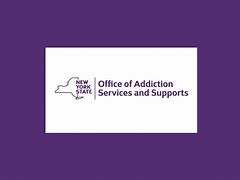
https://oasas.ny.gov
Kai Hellman: The state organization oversees Clubhouse and traditional treatment centers for substance use disorder. It’s the office of alcohol. Nope, sorry. They changed their name. I always get caught up. Office of Addiction Supports and Services. They nicely changed their name from a less stigmatizing name previously.
Clubhouse Radio 31:45
Health Hats: One of you sent me a link to Clubhouse Radio. I looked at that. So could one of you tell us a little bit about Clubhouse Radio?
Phoebs Potter: I’d love to. That was my entree into the Clubhouse four years ago. I had been working with the Ville Arts Center up in the far northern part of Greene County, also working with youth who were in transition, and I had connected with the folks at Wave Farm, Tom, and Galen, and they wanted more youth programming on the air. So we talked to Kai and said, could Clubhouse be a home base for that? We set that up. My role at first was just facilitating that program and the whole vision. I had a co-teacher, Kingston, who came in and got the entire program off the ground too. So, I’ll give him credit. It’s just a space for what we’re talking about, for all these deep insights and perspectives of youth to be part of the conversation going on in the public about what we do about our health crises. But also, a space for them to learn how to use a soundboard and equipment and be responsible for being on the air every Friday at 6:00 PM. Now a prime spot for three years, they’ve gone strong. So, we have two youths every week who are the host and the sound engineer, and they’re set. They invite other youth in as guests, or we have community guests.
And at first, we took a structured approach to the program. We would do a music program. We’d have a topic for three weeks. We’d do music one of those weeks, then poetry and creative writing, and a political, more social discussion. But, over time, we just let go of the adult’s perception of the structure that would work and let them define their structures and ways. Sometimes the most insightful things they say are just random thoughts about the music they decided to play. I have come to embrace its sort of open structure. My role at this point is just like sitting back and ensuring they’re making plans for a show and sending them research snippets. Just for anyone who listens to Clubhouse Radio, it can be a little all over the place, but I just find, as I said, these nuggets of wisdom are nestled all through it. They have run with it and grown tremendously through that. And it’s a beautiful way just to hear what matters to young people, right? What are they into? What’s motivating them? What are their aspirations for the future? That tells us a lot about them and what they need to be.
Narcan and Harm reduction 34:36
Kai Hellman: I just have to say there were a few points I didn’t mention regarding our young adults and our Certified Recovery Peer Advocates (CRPA), and the Narcan training that we do. So, we focused a lot on our youth program, which we tend to do. Because there’s always so much going on. But in addition, our young adult program is for 18 and up. Two certified recovery peer advocates can work with people one-on-one and in group settings and field trips. Like our youth programming, it’s more in the recovery aspect instead of the prevention aspect. Because at that point when you’re 18 and up, you tend to settle into, yeah, I’m a person in recovery, or I’m a person struggling with addiction, or things like that. So, we have those programs available through the youth clubhouse. We’re currently in the Greene County jail doing some groups. One of our CRPAs is in there doing excellent work. So, we’re in both counties doing the thing and want to mention the Narcan training—all the Clubhouse staff. First, I try to hire all Clubhouse staff as people with lived experience, whether it be mental health, disability recovery, or whatever, all the things that make us human. So always trying to hire people with lived experience, people with lived experience. And then, I got myself lost in what I was saying. Narcan, going towards Narcan, our youth and all staff are trained in Narcan from the onset. So that and we’re trained to train. So, we train the community. We can train young people that come in. We can train adults. We train programs. We and all our youth peer leaders are also trained to train. So, we have right now eight youth peer leaders on our payroll, and they’re all trained to train. They’re peers and adults. They also have community events. They’ve had great success doing that.
Health Hats: My hats are off to you guys. Thank you very much. This has been great. This has been wonderful. Thank you for what you do.
Reflection 38:16
See what I meant by my attraction for community-based programs that build partnerships with their participants: the programs serve well, plant seeds, build capacity, and inspire copying? We heard from another such program, a national program, when I interviewed Betsy Cowen Neptune in July 2022 about BUILD – Self-Confidence, Agency, Engagement in Young Adults. Perhaps the episode with Matt Neil, high school teacher, about their Ambassador program is also such a community- (school) based program. What can be copied from these programs – not their flavor or culture – those are hyperlocal. Can you copy community will, collaboration with those served, experimentation, and humility? Those feel organic. Can corporate structure be copied – one is in a school, one state-wide and government-sponsored, and the other private and national? Can we generalize about leadership or technologies? Well, you need humble, visionary leaders. I didn’t hear much about technologies, except for Clubhouse Radio. I was thinking more about app technology. I’m stumped.
Tribute to Casey Quinlan 39:53
For those of you who consumed the April 1st 2023 episode 193, The Mighty Mouth Goes Quiet, Casey Quinlan, Mashup 2021-22, I have the bittersweet news that Casey Quinlan died on April 25th. Bitter, because I’m sad, sweet, because she was ready. Here’s what our mutual friend Colin Hung said in tribute:
On Tuesday, April 25th, 2023, the world lost a bright flame. After a long journey with cancer, Casey Quinlan @MightyCasey passed away peacefully with family and friends by her side. Quinlan was one-of-a-kind and if you had the good fortune of meeting her in person or interacting with her online, she undoubtedly left an impression. She was one of the few people who had zero qualms about speaking her mind – and that is one of the reasons why I admired her.
Outspoken Advocate
I got to know Quinlan through the early #hcldr tweet chats that we hosted (and still host) on Tuesday nights at 8:30 pm ET. At the time, I had never seen someone who was so forthright and direct when expressing healthcare opinions. No matter the topic, Quinlan had piercing insights to share.
Quinlan was an outspoken advocate for better healthcare. She advocated for many improvements including more patient involvement in care decisions, improved access to data, better privacy protection, more accountability from providers/payers/employers, medication affordability, and more patient-led innovation. She was a true believer in the phrase: “Nothing about me without me”.
Quinlan never minced words and was almost always spot-on in her assessment of the situation. I will never forget sitting beside her in breakout sessions and hearing her both heckle the presenter when they made incorrect/inane statements and praise them when they said something insightful. She definitely leaned into her reputation as a “loudmouth” …and those of us who knew her loved her for it.
The QR Code
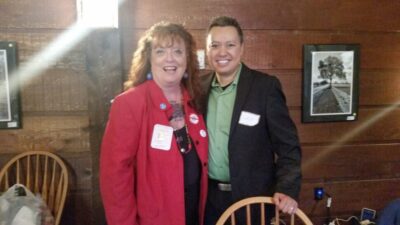
Casey Quinlan and Colin Hung
In addition to her strong advocacy and speaking truth-to-power, Quinlan was well known for the tattoo of QR code on her chest. That QR code was linked to a website where she had documented her medical history and her advanced directives. You can read more about why she did it here: Why I got a QR code tattooed on my sternum
The tattoo was quintessential Quinlan. With it, she took the power away from healthcare institutions and placed it firmly where she believed it should be – with herself as a patient. Her QR code was a not-so-subtle way to stick it to the entire healthcare ecosystem that was too slow and too disinterested in solving access problems for patients.
You can see the QR code in this photo from 2015.
Tribute to Michael Funk 43:46
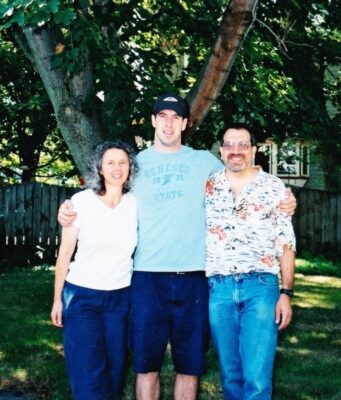
Ann, Mike, Danny
Michael Funk was our son, brother, and friend to us for 11 years. From age fifteen to twenty-six when he died from complications of melanoma. It’s Mike Funk’s 47th birthday today, May 17, as I’m producing. I’m running a film strip in my mind with laughing, crying, perplexing, disgusting, loving scenes. A film strip seems so two-dimensional, while he was so four-dimensional. I’m grateful to have been part of his life for those eleven years. He changed my life. I miss him deeply.
Podcast Outro 44:33
I host, write, record, edit, engineer, and produce Health Hats, the Podcast with production assistance from Kayla Nelson for my website and social media consultation, and managing dissemination plus Leon van Leeuwen transcript editing. Joey van Leeuwen supplies musical support, especially for the podcast intro and outro. I play bari sax on some episodes alone or with the Lechuga Fresca Latin Band. I’m grateful to you, who have the most critical roles as listeners, readers, and watchers. Please subscribe and contribute on Patreon. Help me keep the lights on and out of my retirement funds. See the show notes, previous podcasts, and other resources through my website, www.health-hats.com, and YouTube channel. Link in the show notes. If you like it, share it. See you around the block!
Episode Notes
Please comment and ask questions
- at the comment section at the bottom of the show notes
- on LinkedIn
- via email
- YouTube channel
- DM on Instagram, Twitter, Mastadon to @healthhats
Production Team
Web and Social Media Coach, Dissemination Kayla Nelson @lifeoflesion
Leon van Leeuwen edits the article-grade transcript.
Music on intro and outro by permission from Joey van Leeuwen, Drummer, Composer, and Arranger including Moe’s Blues for Proem and Reflection
Other Credits
Intro photo of Vulture Couple by Rich Rieger used with permission
Photos of dewy flower and foggy holler by Sue Heatherington used with permission
The views and opinions presented in this podcast and publication are solely my responsibility and do not necessarily represent the views of the Patient-Centered Outcomes Research Institute® (PCORI®), its Board of Governors, or Methodology Committee. Danny van Leeuwen (Health Hats)
Sponsored by Abridge
Inspired by and grateful to Dorothy Cucinelli, Betsy Neptune, Matt Neil, Kelly Lane, Jan Oldenburg, Casey Quinlan, Colin Hung
Links
Youth and Young Adults | Office of Addiction Services and Supports (ny.gov)
About Us | Office of Addiction Services and Supports (ny.gov)
Mental Health Association of Columbia Greene MHACG website
Related podcasts
Series: Pediatric Transition to Adult Care
Creative Commons Licensing
The material found on this website created by me is Open Source and licensed under Creative Commons Attribution. Anyone may use the material (written, audio, or video) freely at no charge. Please cite the source as: ‘From Danny van Leeuwen, Health Hats. (including the link to my website). I welcome edits and improvements. Please let me know. danny@health-hats.com. The material on this site created by others is theirs and use follows their guidelines.
